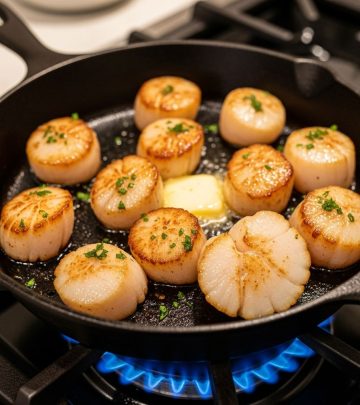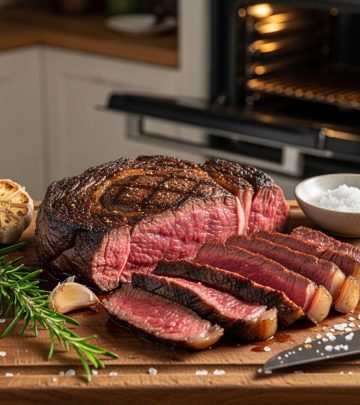The Ultimate Simple Lasagna Recipe: Classic Comfort, Step by Step
Master the art of homemade lasagna with an easy, classic recipe and detailed tips for perfect, cheesy layers every time.

Few dishes capture the soul of Italian comfort food like a bubbling homemade lasagna. Whether you’re a seasoned cook or a kitchen novice, mastering lasagna is a rewarding journey—a symphony of savory sauce, tender pasta, and gooey cheese that brings people together around the table.
Why This Lasagna Recipe Is a Must-Try
This recipe distills the essence of classic lasagna using straightforward steps and simple, everyday ingredients. The result: a hearty, cheese-laden casserole that’s always a crowd-pleaser. Follow along for clear guidance, tips, and everything you need to make lasagna from scratch, plus expert advice from Italian cooks for true traditional flavor.
What You’ll Need: Ingredients & Tools
Before you begin, gather all ingredients and necessary cookware. This ensures a smooth, stress-free cooking experience.
- Pasta: Standard dried lasagna noodles (not no-boil)
- Sauce: Rich, seasoned meat sauce using ground beef, onion, garlic, tomato paste, tomato sauce, and Italian herbs
- Cheeses: A mix of ricotta, mozzarella (shredded or sliced), and Parmesan
- Egg: To mix with ricotta for stability
- Basic pantry staples: Olive oil, salt, pepper, and dried Italian herbs (basil, oregano, thyme)
- Large pot: For cooking noodles
- Large skillet: To prepare the sauce
- Mixing bowls: For combining cheese filling
- 9×13-inch baking dish: For assembling and baking the lasagna
- Foil: For covering during baking
Ingredient Tips: Choosing What Matters
Quality ingredients are the cornerstone of great lasagna. Whenever possible, select:
- Whole-milk cheese for optimal melting and flavor
- High-quality tomato products—they make a visible difference in taste
- Fresh herbs if available, but dried herbs also work well
- Lean ground beef or a beef-pork mix for a more traditional flavor base
Step-by-Step Lasagna Instructions
1. Prepare Lasagna Noodles
Bring a large pot of salted water to a boil. Add lasagna noodles and cook until just al dente, stirring occasionally to prevent sticking. Drain and spread the noodles out on a rimmed baking sheet, drizzling lightly with olive oil to keep them separate.
2. Make the Meat Sauce
- Heat olive oil in a large skillet over medium heat.
- Add chopped onion and cook until translucent, about 5 minutes.
- Add minced garlic and sauté until fragrant.
- Add ground beef (or beef/pork blend) and cook, breaking up the meat until browned.
- Stir in tomato paste and cook for 1 minute for depth of flavor.
- Add tomato sauce and season with salt, pepper, and Italian herbs.
- Simmer until sauce thickens slightly and flavors meld, about 20 minutes.
3. Prepare the Cheese Mixture
- In a medium bowl, combine ricotta cheese, one large egg, and a generous handful of grated Parmesan.
- Season with a pinch of salt and pepper. Stir until smooth and creamy.
How to Assemble Your Lasagna
Layering is key for the perfect texture and balance:
- Sauce Base: Spread a thin layer of meat sauce on the bottom of the baking dish.
- First Noodle Layer: Arrange noodles to cover the sauce, overlapping slightly.
- Cheese Layer: Dollop and spread one-third of the ricotta mixture evenly over noodles. Scatter mozzarella on top and sprinkle with Parmesan.
- Repeat: Add another layer of sauce, then noodles, then cheese. Repeat until all components are used, finishing with sauce and generous cheese on top.
Note: Standard is three layers of noodles, but refill depending on your pan’s depth.
How to Bake Lasagna for Best Results
- Preheat oven to 375°F (190°C).
- Cover the dish tightly with foil to trap steam and keep the cheese from browning too soon.
- Bake covered for 25 minutes, then uncover and bake for an additional 20–25 minutes until the top is golden and bubbling.
- Rest the lasagna for at least 15 minutes before slicing for neat, easy servings.
Expert Tips for Foolproof Lasagna
- Prevent sticking: Toss drained noodles lightly with olive oil before assembly.
- Cheese variety: Mix in fontina or provolone for extra dimension.
- Don’t over-sauce: Excess liquid can result in soggy slices. The sauce should be rich and thick, not watery.
- Let it rest: This step is crucial—resting allows layers to firm up.
- Customize: Add spinach, sautéed mushrooms, or swap in sausage for some or all of the beef.
Make-Ahead and Storage Instructions
- Make ahead: Assemble lasagna up to a day in advance. Cover well and refrigerate before baking. It may need an extra 5–10 minutes in the oven.
- Freezing: Freeze either baked or unbaked. For unbaked, wrap tightly in foil and plastic wrap. Thaw overnight before baking as directed. For baked, cool completely, then freeze in portions or whole. Reheat in oven covered with foil until heated through.
- Leftovers: Store in airtight containers in the refrigerator up to 4 days. Reheat in microwave or oven.
Ingredient Swaps and Variations
- Swap ground turkey or chicken for a lighter version
- Use a bolognese-style sauce (beef, pork, veal, and vegetables simmered in tomatoes and wine) for more traditional flavor
- Vegetarian option: Omit meat; layer roasted vegetables like zucchini and eggplant instead
- Replace ricotta with cottage cheese for a lighter texture
- Try oven-ready or fresh pasta sheets for simpler prep
Pure Italian Advice: Expert Notes on Lasagna Tradition
- No ricotta rule: Some traditional Italian cooks insist béchamel sauce—milk thickened with roux flavored with nutmeg—is essential rather than ricotta.
- Bolognese sauce preferred: Authentic lasagna in northern Italy features slow-cooked bolognese rather than a quick tomato-meat sauce.
- Quality over quantity: Every element, especially cheeses and tomatoes, affects final flavor.
- Don’t overload layers: Each should be balanced for the best bite.
Nutritional Snapshot (per serving)*
| Calories | Protein | Carbs | Fat |
|---|---|---|---|
| ~480 | 28g | 37g | 26g |
*Estimates only, based on standard ingredient quantities.
Serving Suggestions: What to Serve With Lasagna
- Garlic bread or focaccia
- Crisp green salad with vinaigrette
- Roasted vegetables, such as broccoli or carrots
- Simple tomato salad with fresh basil
How to Reheat Lasagna for Fresh Results
- Oven: Cover with foil and bake at 350°F until heated through, 20–30 minutes for a whole pan.
- Microwave: Heat slices on a microwave-safe plate, covered, until hot throughout.
- Add a splash of water or sauce before reheating to keep moist.
Frequently Asked Questions (FAQs)
Q: Can I prepare lasagna ahead of time?
A: Yes. Assemble up to a day in advance and refrigerate. Add extra baking time if chilled. Lasagna can also be frozen baked or unbaked for later meals.
Q: What’s the best way to freeze lasagna?
A: For unbaked lasagna, wrap tightly in plastic and foil, label, and freeze up to 3 months. Thaw overnight in fridge and bake as usual. Baked lasagna can be frozen in portions for quick reheating.
Q: Can I use no-boil noodles?
A: Yes. Layer directly with sauce and cheese—the additional moisture helps them cook through. Add a bit more sauce if using no-boil noodles for the best texture.
Q: Why is my lasagna watery?
A: Excess liquid can come from thin sauce, overcooked noodles, or skipping the rest period. Use a thick, rich sauce, don’t overcook noodles, and always allow to rest before slicing.
Q: Can I make lasagna without meat?
A: Absolutely. Substitute roasted vegetables, spinach, or mushrooms for ground meat, and proceed with the same assembly steps.
Q: How do I get neat slices?
A: Let lasagna rest for at least 15 minutes after baking. Use a sharp, thin-bladed knife and wipe between cuts for clean slices.
Final Thoughts
Homemade lasagna is more than a recipe—it’s a tradition, an act of love, and a delicious invitation to slow down and savor. Whether you serve it for Sunday dinner, a special occasion, or simple weeknight comfort, this classic, straightforward lasagna will become a staple in your kitchen.












